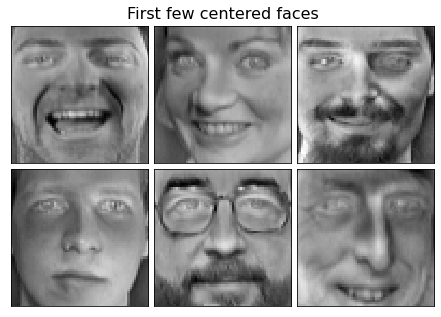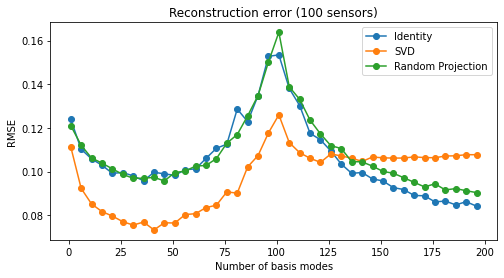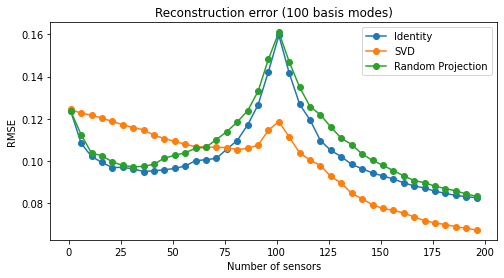Basis comparison¶
Compare reconstruction performance of different choices of basis: * Raw input * SVD/POD modes * Random projections
We’ll perform comparisons using Olivetti faces dataset from AT&T.
from time import time
import warnings
import matplotlib.pyplot as plt
import numpy as np
from sklearn import datasets
import pysensors as ps
Setup¶
Data consists of 10 pictures of 40 different people, each 64 x 64.
faces = datasets.fetch_olivetti_faces(shuffle=True, random_state=99)
X = faces.data
n_samples, n_features = X.shape
print(n_samples, n_features)
400 4096
# Global centering
X = X - X.mean(axis=0)
# Local centering
X -= X.mean(axis=1).reshape(n_samples, -1)
# From https://scikit-learn.org/stable/auto_examples/decomposition/plot_faces_decomposition.html
n_row, n_col = 2, 3
n_components = n_row * n_col
image_shape = (64, 64)
def plot_gallery(title, images, n_col=n_col, n_row=n_row, cmap=plt.cm.gray):
plt.figure(figsize=(2. * n_col, 2.26 * n_row))
plt.suptitle(title, size=16)
for i, comp in enumerate(images):
plt.subplot(n_row, n_col, i + 1)
vmax = max(comp.max(), -comp.min())
plt.imshow(comp.reshape(image_shape), cmap=cmap,
interpolation='nearest',
vmin=-vmax, vmax=vmax)
plt.xticks(())
plt.yticks(())
plt.subplots_adjust(0.01, 0.05, 0.99, 0.93, 0.04, 0.)
plot_gallery("First few centered faces", X[:n_components])

We’ll learn the sensors using the first 300 faces and use the rest for testing reconstruction error.
X_train, X_test = X[:300], X[300:]
Reconstruction error¶
Varying the number of basis modes¶
First we’ll fix the number of sensors at 100 and see how the number of basis modes used affects the reconstruction error.
max_basis_modes = 200
n_sensors = 100
models = [
(
'Identity',
ps.SSPOR(
n_sensors=n_sensors,
basis=ps.basis.Identity(n_basis_modes=max_basis_modes)
)
),
(
'SVD',
ps.SSPOR(
n_sensors=n_sensors,
basis=ps.basis.SVD(n_basis_modes=max_basis_modes)
)
),
(
'Random Projection',
ps.SSPOR(
n_sensors=n_sensors,
basis=ps.basis.RandomProjection(n_basis_modes=max_basis_modes)
)
),
]
fig, ax = plt.subplots(1, 1, figsize=(8, 4))
ax.set(
xlabel="Number of basis modes",
ylabel="RMSE",
title=f"Reconstruction error ({n_sensors} sensors)",
)
n_basis_modes_range = np.arange(1, 200, 5)
# Suppress warning arising from selecting fewer basis modes than
# the number of examples passed to the Identity basis
# (results in some examples being thrown away)
with warnings.catch_warnings():
warnings.filterwarnings("ignore", category=UserWarning)
for name, model in models:
t0 = -time()
model.basis.fit(X_train)
print(f"Train time for {name} basis: {time() + t0}")
errors = np.zeros_like(n_basis_modes_range, dtype=np.float64)
for k, n in enumerate(n_basis_modes_range):
model.update_n_basis_modes(n, X_test, quiet=True)
errors[k] = model.reconstruction_error(X_test, [n_sensors])[0]
ax.plot(n_basis_modes_range, errors, "-o", label=name)
ax.legend()
plt.show()
Train time for Identity basis: 0.004990577697753906
Train time for SVD basis: 1.3857293128967285
Train time for Random Projection basis: 0.031676530838012695

The Random projection and Identity bases give similar performance, with Identity winning out for larger numbers of modes. The POD basis performs best for smaller numbers of modes, but its accuracy tapers off as the number of basis modes grows large.
Varying the number of sensors¶
Next we’ll explore the reconstruction error for a fixed number of basis modes (100) as the number of sensors is varied.
n_basis_modes = 100
models = [
(
'Identity',
ps.SSPOR(basis=ps.basis.Identity(n_basis_modes=n_basis_modes))
),
(
'SVD',
ps.SSPOR(basis=ps.basis.SVD(n_basis_modes=n_basis_modes))
),
(
'Random Projection',
ps.SSPOR(basis=ps.basis.RandomProjection(n_basis_modes=n_basis_modes))
),
]
fig, ax = plt.subplots(1, 1, figsize=(8, 4))
ax.set(
xlabel="Number of sensors",
ylabel="RMSE",
title=f"Reconstruction error ({n_basis_modes} basis modes)",
)
sensor_range = np.arange(1, 200, 5)
for name, model in models:
t0 = -time()
model.fit(X_train, quiet=True)
print(f"Train time for {name} basis: {time() + t0}")
errors = model.reconstruction_error(X_test, sensor_range=sensor_range)
ax.plot(sensor_range, errors, "-o", label=name)
ax.legend()
plt.show()
Train time for Identity basis: 0.04640030860900879
Train time for SVD basis: 0.6055629253387451
Train time for Random Projection basis: 0.07513236999511719

When the sensor count is small, Identity and Random projection bases produce the best reconstruction error. As the number of sensors grows, the POD basis wins out.
Sensor locations¶
Let’s compare the sensor locations for the three bases.
fig, axs = plt.subplots(1, 3, figsize=(15, 4))
n_sensors = 60
for ax, (name, model) in zip(axs, models):
img = np.zeros(n_features)
sensors = model.get_all_sensors()[:n_sensors]
img[sensors] = 16
ax.imshow(img.reshape(image_shape), cmap=plt.cm.binary)
ax.set(title=name, xticks=[], yticks=[])

Similar sensor locations are chosen for this dataset across all three bases considered.
Download python script: basis_comparison.py
Download Jupyter notebook: basis_comparison.ipynb